A serious photography enthusiast or a professional expects no compromise from the shooting rig they’re about to purchase, especially when spending a large sum of money on it.
We know you’d have done your homework properly before diving into this purchase decision, but anyway we decided to chip in with our share of expertise on this topic.
Here is the article we researched and wrote about the nine best digital cameras available in the Indian market capable of taking the photography experience to a whole new level when combined with your inner creativity.
Winding up the loose talk, let’s get real and start the article!
Best DSLR Camera In India
| 1. Canon EOS R6 | Overall Best Pick |
| 2. Sony Alpha ILCE-7S III | Runner-up Pick |
| 3. Nikon D7500 | Value for Money Digital Camera |
| 4. Fujifilm X-T4 | Best Versatile Camera |
| 5. Panasonic Lumix G100 | Best Vlogging Camera |
| 6. Canon EOS 80D | Feature-rich Camera |
| 7. Nikon D500 | Best Camera for Sports and Wildlife Photography |
| 8. Fujifilm X-Pro3 | Best Build Quality |
| 9. Nikon Z50 | Honourable Mention |
Note: The price shown are the once when we reviewed the products. However, as the promotional offers changes on the given E-commerce sites, the price may vary. Bettershark is supported by it’s readers and when you buy through links on our site, we may earn an affiliate commission.
1. Canon EOS R6
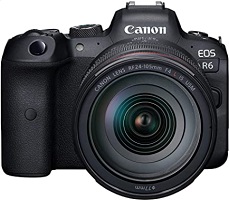
Overall Best Pick
- 20.1 MP CMOS Sensor
- 5-Axis In-body image stabilization
- Video recording at 4K 60fps
Pros
Premium build quality
Fast AF performance
100% EVF coverage
Cons
Expensive
The Canon EOS IS a series of autofocus single-lens reflex cameras and mirrorless cameras. EOS in the name stands for Electro-Optical System.
The Canon EOS R6 is a high-end full-frame mirrorless camera that retails for Rs.3,14,990 in the Indian market.
Design and Build Quality
The Canon EOS R6 features an ergonomic design and it is a joy to use out in the field. Canon has made a camera that has a smooth finish and without any jagged edges which makes it comfortable to hold in the hands.
For its construction, Canon has used a combination of polycarbonate material and magnesium alloy. On the other hand, the camera feels well built and put together with great care. The sophistication in its design gives it quite a professional feel.
The dials and other controls on the camera are placed similar to the more premium Canon EOS R5 camera albeit there is the lack of an information LCD on the top plate.
At the rear face of the camera, there is the 3-inch fully articulating LCD screen. This LCD screen is touch capacitive which means you can easily move through and select the options on the camera with your fingers.
This camera also features an electronic viewfinder that provides 100% coverage when clicking snaps without any crop.
Sensor Features
The Canon EOS R6 features the 20.1 MP CMOS sensor coupled with the DIGIC X image processor.
This sensor comes with an impressive ISO range covering between 100 – 102400 for taking breathtaking stills in all lighting conditions.
Canon has included only a single lens kit with the camera body. The lens kit included is the RF24-105mm which is a full-frame lens.
Autofocus on the Canon EOS R6 is exceptional thanks to the Dual Pixel CMOS AF covering approx. 100% Area with 1,053 selectable AF points. You can also set or drag the autofocus point using the LCD touchscreen.
One of the main features of the Canon EOS R6 is the inclusion of a 5-axis in-body image stabilization. The image stabilization on the lens combined with in-body image stabilization almost eliminates any unnecessary movements when taking stills or recording videos.
Speaking of videos, this camera can record videos at 4K up to 60fps or if you want a more cinematic experience then you can record at 24fps.
Miscellaneous
This device comes with Wi-Fi connectivity which can be used for sharing photos and videos wirelessly to your smartphones or laptops without any fuzz.
With the camera, you also get some accessories such as the lens hood, pouch, and a shoulder strap bundled in the box.
Battery Life
The Canon EOS R6 is powered by a rechargeable Li-ion battery pack for powering its functions.
This battery can last for up to 510 shots on a single full charge while using the LCD or approximately 380 shots with the viewfinder.
Verdict
The Canon EOS R6 is one beast when it comes to its performance. This camera is ideal for professional photographers who want a camera that will be able to capture beautiful images and videos no matter what the weather or lighting conditions.
Specifications
| Sensor Size | 36 x 24 mm |
| Lens | Canon Lens RF 24-105mm |
| Megapixel Count | 20.1 MP |
| Display Size | 3-inch. |
| Warranty | – |
2. Sony Alpha ILCE-7S III
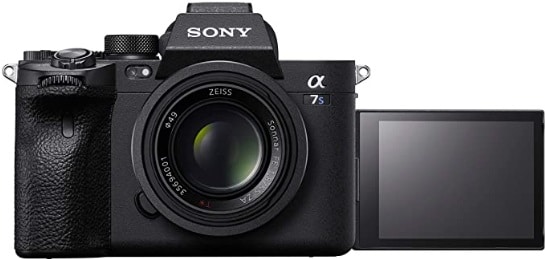
Runner-up Pick
- 12.1 MP Exmor RTM CMOS sensor
- 3-inch touchscreen LCD
- 759 Autofocus points
Pros
Excellent low-light performance
Long battery life
Type-C charging
Cons
Expensive
Sony is a company that needs no introduction. It is one of the biggest electronics companies in the world and is a market leader in the audio, video, and gaming industries.
The Sony Alpha ILCE-7S III is a premium mirrorless camera that retails for around Rs.3,00,000 in the Indian market.
Design and Build Quality
The Sony Alpha ILCE-7S III is one of the most premium and well-built mirrorless cameras you will find in the Indian market.
Being a mirrorless camera, it is quite compact compared to DSLR cameras which makes it easier to carry around with you during fieldwork.
The moment you lay your hands on the Sony Alpha ILCE-7S III, you will know that it is not any ordinary camera and is one hell of a beast. The build quality of the camera is extremely good and the camera feels well put together.
For easy handling, the camera has reasonably sized textured grip inserts. There are plenty of buttons and dials on the camera along with a joystick that is used to navigate the menu.
In the rear face of the camera, there is the articulating 3-inch LCD screen with 1.44 million dot resolution. This screen is quite sharp and there is no problem viewing it outdoors under direct sunlight. This LCD is a touchscreen which means you can browse through the menus of the camera using your finger or the joystick if you prefer something more old school.
Furthermore, the camera is not only limited to the LCD for viewing your subjects. It also features a sharp electronic viewfinder that delivers crisp clarity and provides 100% coverage which is a photographer’s dream.
Sensor Features
The Sony Alpha ILCE-7S III features a 12.1 MP Exmor RTM CMOS image sensor. This camera also features a powerful BIONZ XR with up to 8x processing performance.
This here is just the camera body that can be mounted with a wide variety of E-mount lenses by Sony which is available for purchase. There is a wide range of E-mount lenses available which let you take wide, portrait, zoom, and many other pictures.
The low-light capabilities of this camera are excellent. You will notice right away when taking pictures in low light that this camera is one of the best.
One of the most important features of this camera and what it is meant for is videography.
The Sony Alpha ILCE-7S III can record stunning videos at 4K resolution. The videos taken on this camera look extremely professional and crisp. If you have the budget then this camera should be on your priority list. You will be impressed with how long this camera can record videos at 4K.
Autofocus on this camera also works well. The camera has 759 autofocus points and an advanced eye-tracking feature which is 30% faster than the previous Sony camera.
Miscellaneous
The Sony Alpha ILCE-7S III has storage for two SD cards which means you can store more content on the camera.
This camera also has NFC support that lets you share images with your smartphone just with one tap. Wi-Fi connectivity is also supported, you can download the companion app on your smartphone which lets you remotely control the camera.
Battery Life
The Sony Alpha ILCE-7S III is powered by the NP-FZ100 battery pack that lasts for approximately 600 shots or 130 minutes of continuous recording which is impressive.
This mirrorless premium camera supports Type-C USB which means you can hook up your mobile charger to juice up the battery.
Verdict
So who is the Sony Alpha ILCE-7S III for?
Without a doubt, the Sony Alpha ILCE-7S III is meant for professional photographers and videographers that often work in lowlight conditions and want the absolute best image quality.
Specifications
| Sensor Size | 35.6 x 23.8 mm |
| Lens | E-mount lens |
| Megapixel Count | 12.1 MP |
| Display Size | 3-inch. |
| Warranty | 2 Year |
3. Nikon D7500
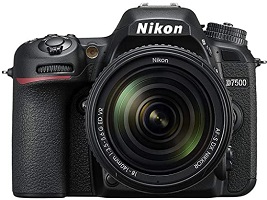
Value for Money Digital Camera
- 20.9MP APS-C CMOS sensor
- 3.2-inch LCD touchscreen
- Wi-Fi and Bluetooth support
Pros
Good weather sealing
Optical viewfinder that provides 100% coverage
51 point autofocus
Cons
4K recording gets cropped
Nikon is a company that you will come across often when you are in the search for cameras. They are a multinational Japanese company that manufactures imaging-related products such as cameras and printers.
The Nikon D7500 is a premium DSLR camera in the Indian market available for just under Rs.90,000.
Design and Build Quality
The Nikon D7500 is a hefty DSLR camera which is a change from the more compact mirrorless cameras.
The build quality of this DSLR camera is outstanding with the use of hard polycarbonate plastic materials and rubber inserts over a metallic inner frame. The weather sealing of the Nikon D7500 is also vastly improved over its predecessor.
In the rear face, we get the 3.2-inch tilting LCD screen. The LCD is also touch-capacitive which is much appreciated, meaning you can easily browse through the menus and options of the camera using your finger.
Now for more old-school photographers this camera also features an optical viewfinder which provides 100% coverage. This means what you see is what you get.
Buttons and dials on the camera have been neatly placed around the top plate and rear of the camera for ease of access.
I/O ports on the Nikon D7500 include an HDMI port, USB port, accessor terminal, microphone, and headphone jack.
Sensor Features
The Nikon D7500 features a 20.9MP APS-C CMOS sensor with an ISO range of 100-51,200, which is expandable to 50-1,640,000.
Nikon has included an 18-140mm AF-S lens kit with the camera. The lens provides a good zoom range and optical performance.
In terms of the image quality, Nikon cameras are known for their good dynamic range, it produces natural-looking colours, and the details captured remain crisp.
The camera features a 51-point Multi-Cam 3500 II autofocus sensor. It is possible to switch between manual focus and autofocus by sliding the lever on the lens flange.
Videographers would be delighted to know that the Nikon D7500 can record videos in 4K resolution at 30 fps. Unfortunately, though there is a 1.5x crop factor while recording videos which can be quite concerning if you want to record videos at a wide-angle.
Miscellaneous
On the connectivity front, this camera has both Wi-Fi and Bluetooth connectivity that can be used to command and control the device remotely from your smartphone or laptop and also aids in wireless media synchronization.
Unfortunately, there is no NFC connection on the Nikon D7500 which is disappointing for such a premium DSLR camera.
Battery Life
The Nikon D7500 comes with a rechargeable EN-EL15a Li-ion battery pack for powering its functions.
This battery pack can roughly last for 950 shots and about 80 minutes of intermittent video recording at full HD, 60 fps.
Verdict
The Nikon D7500 is an excellent DSLR camera that can record videos at 4K resolution and the image quality of the 20.9 MP APS-C sensor is also one of the best in its price range.
Specifications
| Sensor Size | 23.5 x 15.6mm |
| Lens | Nikkor Lens |
| Megapixel Count | 20.9 MP |
| Display Size | 3.2-inch |
| Warranty | 2 Years |
4. Fujifilm X-T4
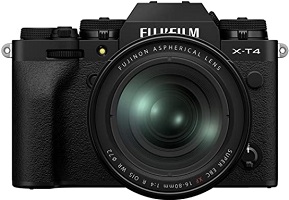
Best Versatile Camera
- OLED viewfinder
- 4K recording at 60fps
- 26.1MP APS-C X-Trans CMOS sensor
Pros
Type-C power delivery
Metal chassis
In body image stabilization
Cons
Expensive
Fujifilm is one of the oldest and well-known companies that you will come across while researching imaging-related products. This Japanese brand is one of the most reputable companies in the world because of its high-quality cameras.
The Fujifilm X-T4 is a mirrorless camera that excels in both photography and videography. It retails for a premium of around Rs.1,80,000 in the Indian market.
Design and Build Quality
The Fuji X-T4 frankly looks quite similar to its predecessor the X-T3 in terms of its design. This is not necessarily a bad thing but there are also some noticeable improvements over its predecessor.
First off, the new X-T4 has a chunkier build compared to its predecessor. The hand grips feel more sturdy and provide superior grip. The chassis of this camera is made completely out of metal and feels extremely premium in hand.
The LCD on the X-T4 is now fully articulating unlike the fixed LCD on the X-T3. The screen has a size of 3-inch and is also a touchscreen. There is also the OLED viewfinder in the X-T4 and there isn’t much change in its specifications except you now have an eye cup for comfort.
All the buttons and dials of the camera are well placed. The buttons are quite responsive as well.
There are metal hooks on either side that can be utilized to connect a wrist strap to ensure that this camera won’t slip away from your hand accidentally
I/O ports on the X-T4 include mini HDMI, Type-C USB, a microphone jack, and a port for the shutter release remote.
Sensor Features
The Fujifilm X-T4 features a 23.5 x 15.6mm 26.1MP APS-C X-Trans CMOS sensor with a maximum ISO range of 12800.
Autofocus on the X-T4 has improved albeit it uses the same AF system in the X-T3. The autofocus algorithm has been enhanced to take into account shapes and colours. Even in low light, the performance in still images is excellent.
Bundled with the Fujifilm X-T4, you can either opt for the 16-80mm or 18-55m lens kit.
The picture quality of the X-T4 is similar to that of the X-T3. This translates to appealing JPEGs, solid RAW mode results, and the addition of new in-body image stabilization to support slower shutter speeds.
The video recording capabilities of the X-T4 are something to take into consideration as well. The X-T4 can record videos at crisp 4K resolution at 60fps or FHD video at up to 240fps which gives you 10x slow-motion footage. The videos come out stabilized and highly detailed making this one of the features you should consider.
Battery Life
There has been a substantial improvement in the battery life of the X-T4 when compared with its predecessor. This camera is powered by an NP-W235 Li-ion battery pack that is rated to last approximately 600 shots in economy mode and around 500 shots in normal mode.
Continuous recording at 4K delivers a battery life of 110 minutes which is appreciable for a mirrorless camera.
This camera supports Type-C power delivery for juicing up the battery apart from the regular charging method.
Verdict
The Fujifilm X-T4 is an excellent camera for someone who often switches between taking stills and recording videos. The premium build quality along with the wide range of features make the camera well worth the asking price.
Specifications
| Sensor Size | 23.5 x 15.6mm |
| Lens | Fujinon Aspherical Lens |
| Megapixel Count | 26.1 MP |
| Display Size | 3-inch. |
| Warranty | – |
5. Panasonic Lumix G100
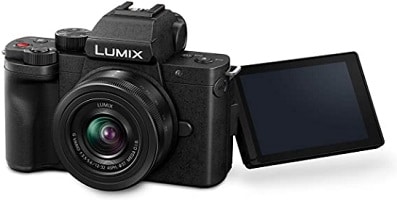
Best Vlogging Camera
- Articulating LCD screen
- Wi-Fi and Bluetooth connectivity
- 20 MP Four Thirds sensor
Pros
Three inbuilt microphones
In body image stabilization
Compact size
Cons
The crop is applied in 4K videos
Poor low light performance
The Panasonic Lumix lineup is popular in the DSLR and digital camera market well known for its prowess in video quality and stabilization.
The Lumix G100 by Panasonic is a premium mirrorless camera that retails for around Rs.60,000 in the Indian market.
Design and Build Quality
The Lumix G100 is touted by Panasonic as the ultimate vlogging camera and to know how true these claims are let us go a bit into detail of what this camera has to offer.
First off the design of this compact yet premium mirrorless camera is quite similar to that of a mirrorless camera by any other company albeit there are some small yet significant changes.
The material used by Panasonic for the construction of Lumix G100 is a tough polycarbonate material that feels durable.
An essential feature for a vlogging camera would be an articulating LCD screen and thankfully the Lumix G100 features an excellent 3-inch articulating LCD screen that is also a touchscreen.
For those who don’t prefer an LCD screen, this camera also has an electronic viewfinder that lets you visualize the frame and click pictures.
This camera has three inbuilt microphones which pick up sounds even when there is no external microphone being used.
Sensor Features
The Panasonic Lumix G100 features a 20MP CMOS sensor. The sensor inside this compact mirrorless camera has a size of 17.3 x 133mm.
Under good lighting conditions, this 20MP sensor on the camera delivers pictures with very good details and colour accuracy.
Where the Lumix G100 struggles is in low light, due to the small sensor size the images are not as great when shot in broad daylight but to help you take pictures the camera does have an in-built pop-up flash.
The lens kit provided with the camera is the 12-32mm G VARIO lens which lets you capture excellent wide shots.
This camera also supports 4K video recording at 30fps but unfortunately, a crop is applied when recording in 4K which means for vloggers they would have to keep the camera a bit distanced from their head.
Panasonic has included 5-axis in-body image stabilization in the Lumix G100 which means that pictures will not appear blurry and videos would be stable without any unintentional movement.
However, if you want the best stabilization you will need to purchase a gimbal.
Miscellaneous
With the Lumix G100 camera, Panasonic has also included a tripod grip on which you can mount your camera. This grip lets you vlog with ease and take stills without any shake.
The camera has a wide range of connectivity options such as micro HDMI, USB 2.0, microphone jack, Bluetooth, and Wi-Fi connectivity.
Thanks to Wi-Fi and Bluetooth you can easily share pictures with your smartphone in an instant. The Lumix G100 can also be controlled using your smartphone remotely using the Panasonic app.
Battery Life
Mirrorless cameras usually provide less battery life than DSLR cameras. This is because the size of such cameras is smaller which means you need a smaller battery pack.
The Lumix G100 features a BLG10 rechargeable lithium-ion battery pack that is rated to last approximately for just around 270 shots.
Verdict
If you are a vlogger or are someone who is planning on vlogging then look no further because the Panasonic Lumix G100 is no doubt the best camera in the Indian market for vloggers. With in-body image stabilization and three inbuilt microphones, you are ensured to have a good vlogging experience.
Specifications
| Sensor Size | 17.3 x 13 mm |
| Lens | LUMIX G VARIO |
| Megapixel Count | 20 MP |
| Display Size | 3-inch. |
| Warranty | 2 Years |
6. Canon EOS 80D

Feature-rich Camera
- 45-point hybrid AF system
- DIGIC 6 image processor
- 24.2 MP APS-C CMOS sensor
Pros
Weather-sealed body
Multiple scene modes
Excellent battery life
Cons
No 4k video recording
The Canon EOS 80D is an enthusiast-level DSLR camera that is the follow-up to the company’s 70D camera.
Made for more advanced photography, this camera retails for Rs.89,990 in the Indian market.
Build and Design
In terms of the build quality, this DSLR camera features a polycarbonate exterior whereas the chassis is made from magnesium alloy.
All in all the body of the camera feels rugged. Furthermore, this camera is also weather-sealed against dust and moisture.
Design-wise the camera looks nearly identical to its predecessor.
In the rear face, the camera houses the 3-inch articulating touchscreen LCD through which the majority of the controls are accessible. The buttons next to the touchscreen can also be used to navigate through the menus.
The top of the camera hosts a multitude of buttons and dials. These buttons include the shutter button, power button, AF, drive, ISO, etc. This camera is fitted with an EF-S compatible lens mount.
Camera features
The Canon EOS 80D features a 24.2 MP APS-C CMOS sensor with a dual-pixel on-sensor phase-detection autofocus system. This sensor has a resolution of 6000 x 4000 pixels. This camera features a DIGIC 6 image processor.
This camera as mentioned before is compatible with EF-S compatible lenses. The lens kit that is bundled with the camera is the EF-S 18-135mm.
The camera features a multitude of scene modes such as food, kids, portrait, landscape, etc.
The 80D also gains a new 45-point hybrid AF system with all of the points being cross-type. It is an upgrade over the 19-point AF system.
Speaking about connectivity, this camera has NFC and Wi-Fi support. This means you can easily connect the camera to your smartphone or tablet to share pictures seamlessly.
Image Quality and Video Quality
The 80D’s 24-megapixel sensor produces detailed, stunning photos that are suitable for any reasonable print size.
Canon’s DIGIC 6 image processor has received acclaim for its improvements in noise handling and dynamic range.
Raw noise performance on the Canon EOS 80D is broadly the same as its predecessor, even at the highest ISOs.
In terms of video quality, this camera can record videos at a maximum resolution of 1080p at 60 fps. It would have been nice to have a 4K 30 fps option considering the price of the camera.
Battery Life
The Canon EOS 80D is equipped with an LP-E6N lithium-ion battery pack. The battery on this camera is rated to last for 960 shots which is excellent for a mid-range DSLR camera.
Verdict
The Canon EOS 80D is not the best camera out there but that is not of importance. What is important is that this camera is a joy to use. It can make a great backup camera for a photographer or this camera is also suitable for someone who is upgrading from an old variant.
Specifications
| Sensor Size | 22.5 x 15 mm |
| Lens | Canon Lens EF-S 18-135mm |
| Megapixel Count | 24.2 MP |
| Display Size | 3-inch |
| Warranty | 2 Years |
7. Nikon D500
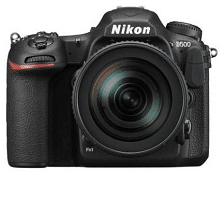
Best Camera for Sports and Wildlife Photography
- Optical viewfinder with 100% coverage
- 1240 Shots battery life
- 153-point AF system
Pros
4K UHD Video recording
Tiltable LCD touchscreen
Rugged camera body
Cons
No built-in flash
The D500 is not the latest camera by Nikon. This camera came out back in 2016 but most cameras are quite relevant years after they are released. This camera is still going strong and quite popular among the crowd.
The Nikon D500 is a DSLR camera that retails for Rs.1,69,999 in the Indian market.
Build and Design
The Nikon D500 is not a camera for beginners. This DSLR is suitable for professional photographers.
This camera is the spiritual successor to the now discontinued Nikon D300S.
This digital camera has a rugged build just like the D300S. In terms of build quality, this camera has a metal chassis and a polycarbonate exterior. The camera is weather sealed which means that you can use it in harsh weather conditions.
Nikon has omitted the pop-up flash on the camera which can be disappointing for some but you can add an external flash thanks to the hot shoe mount present.
This camera feels solid, at the front is the handgrip with a textured coating making for a comfortable holding experience.
The camera houses a 3.2-inch tiltable LCD touchscreen that can be used to navigate through the menus or you can use the buttons present on the camera as well.
Speaking about the buttons, many buttons throughout the camera can be pressed to adjust its various functions and settings.
At the top of the camera is the mode dial, shutter button, power button and many more. A secondary LCD is also present on the top which shows details like the image format, battery life, etc.
Camera Features
The Nikon D500 features a 20.9 MP APS-C-format DX CMOS sensor coupled with the Expeed 5 processor.
The lens on the camera is the Nikon F-Mount. You can attach any of the F-Mount lenses to the camera. The lens kit bundled with the camera is the AF-S DX 16-80mm lens.
This camera has a 153-point AF system. It includes face detection, live tracking, etc. Manual focus is also possible in the camera.
The Nikon D500 also comes with an optical viewfinder that provides 100% coverage. So you do not have to worry about the crop in the field of view.
Sharing your images across devices has never been easier, thanks to the NFC, Wi-Fi, and Bluetooth support on the Nikon D500 you can easily share pictures to your smartphone or tablet.
Image and Video Quality
Most of the time, the D500 performs well. The vast majority of the photographs are clear, well-exposed, and have appealing, realistic colours. The video quality is likewise excellent.
Upon further inspection, it is also observed that the low-light performance of the camera is also very good within the native sensitivity range. Images taken in low light have a good amount of detail.
This camera is going to be loved by sports and wildlife photographers. Thanks to the fast and accurate AF system you can click shots in no time.
The contrast-detection autofocus system that operates when the camera is in Live View or video mode also seems a little better than the ones in Nikon’s previous DX cameras.
Speaking about video mode, this camera can record videos at 4K resolution at 30 fps and also 1080p resolution at 60 fps.
Battery Life
The Nikon D500 features a rechargeable EN-EL15 battery pack. The battery of this camera is rated to last for approximately 1240 shots which is quite good.
It has an excellent battery life and you won’t have to worry about charging it all the time.
Verdict
The Nikon D500 is an excellent DSLR camera for sports and wildlife photographers thanks to its ability to take snapshots quickly. The AF system on the camera is excellent and the ability to record videos at 4K resolution is also appreciated.
As mentioned before this camera is for professional or enthusiast photographers and not suitable for someone new to photography.
Specifications
| Sensor Size | 23.5 x 15.7 mm |
| Lens | Nikkor F Mount |
| Megapixel Count | 20.9 MP |
| Display Size | 3.2-inch |
| Warranty | 2 Years |
8. Fujifilm X-Pro3
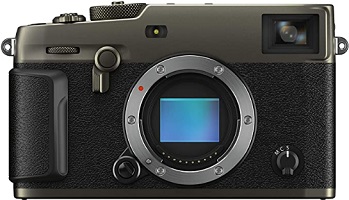
Best Build Quality
- 26 MP APS-C BSI CMOS 4 sensor
- 4k video recording
- Hybrid viewfinder
Pros
Film simulation modes
Titanium top and bottom plate
Duratect layer for scratch protection
Cons
Not for beginners and amateurs
When speaking about photography Fujifilm is a company that needs no introduction as it is one of the oldest companies in the world that started manufacturing imaging-related products and still does to this day.
The Fujifilm X-Pro3 is a high-end mirrorless camera that retails for around Rs.1,70,000 in the Indian market.
Design and Build Quality
At first glance, it is understood that Fujifilm is still trying to retain their retro yet modernized look for the Fujifilm X-Pro3 which does make the camera visually appealing to look at albeit not dragging too much attention.
Materials used for the construction of the camera are without a doubt premium. The camera has a magnesium alloy body whereas the top and bottom plate of the camera is made from titanium which is one of the strongest metals on the planet.
The camera has a textured finish and there is a handgrip on the front of the camera which makes it a delight to hold. Fujifilm has also coated the camera with their Duratect layer which provides added protection against scratches.
In the rear of the camera, Fuji has added an articulating LCD screen which also has a mini LCD screen on its opposite end. The mini screen is meant to encourage a more traditional shopping experience with the viewfinder of the camera rather than depending on the LCD screen.
The buttons and dials of the camera are also well positioned making them easily accessible without having to struggle too much.
The viewfinder on the camera is a hybrid and is both an OVF and EVF. The OVF is meant for photographers that seek the more traditional experience while the EVF is for the new generation of photographers.
Sensor Features
The sensor on the Fujifilm X-Pro3 is almost similar to the Fujifilm XT-4. It has a 26MP APS-C BSI CMOS 4 sensor that captures beautiful images.
This camera is compatible with the Fujifilm X mount lens. There is a wide range of lenses to choose from which are suitable for various situations.
In terms of noise and dynamic range, the 26MP sensor performs marvellously, and the colour choices are as good as they’ve ever been.
The X-Pro3 features a new HDR drive mode that combines three levels of exposure to give you excellent results.
This camera can shoot in Raw which can further be converted into JPEGs. The image quality of the camera is just excellent.
Autofocus on the camera is impressive, it has excellent subject tracking, face, and eye detection. It works with the LCD screen, EVF and OVF. But it works best with EVF.
Video recording also plays an important role with X-Pro3 and you will be glad to know that the Fujifilm X-Pro 3 can record videos at 4K resolution and the videos end up crisp. You can also use the Film Simulation Modes available on the camera for cool effects.
Miscellaneous
This camera supports common wireless connectivity standards such as Wi-Fi and Bluetooth that let you seamlessly transfer pictures from your camera to your smartphone.
Unlike some other Fuji cameras, the X-Pro3 does not come with an HDMI port which is quite disappointing but you do get a Type C USB port
Battery Life
Mirrorless cameras usually provide less battery life than DSLR cameras. This is because the size of such cameras is smaller.
However, the Fujifilm X-Pro3 can capture up to 440 frames and record 4K videos continuously for up to 60 minutes on a single full charge.
Verdict
The Fujifilm X-Pro3 is an excellent camera that is aimed more towards professional photographers since beginners and amateurs will have a tough time getting a hang of it. The hybrid viewfinder is best in class and film simulation modes let you be creative.
Specifications
| Sensor Size | 23.5 x 15.6mm |
| Lens | Fujinon Aspherical Lens |
| Megapixel Count | 26.1 MP |
| Display Size | 3-inch |
| Warranty | 2 Years |
ALSO READ: Best Action Camera in India
9. Nikon Z50
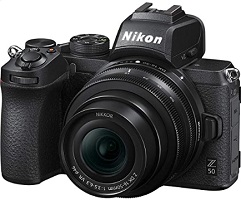
Pros
Ergonomic design
Robust build quality
Weather sealed camera
Cons
Poor battery life
The Nikon Z50 is a mirrorless camera that is aimed at professional photographers and beginners alike.
This is the first time Nikon has put an APS-C sensor on their Z series of cameras.
Design and Build Quality
The Nikon Z50 looks like a scaled-down version of the Z6 and Z7 mirrorless cameras with a new hump for the electronic viewfinder.
Nikon has ergonomically designed the camera to be comfortable in hand and the compact size along with the textured grip make it a breeze to hold.
In terms of the build quality, the front of the camera along with the top plate and grip have been constructed with a magnesium alloy while the remaining material used is rubber and plastic.
The controls and dials on the camera are also made from plastic. Everything is neatly arranged with enough spacing between the controls so you won’t strain your fingers while reaching for them.
Nikon claims that the body of the camera is also weather-sealed to an extent. There won’t be any issues while using the camera in extreme weather conditions.
The 3-inch TFT LCD touchscreen at the back can be tilted 90 degrees upwards and 180 degrees downwards that will provide you with abundant experimental shooting angles.
Sensor Features
The Nikon Z50 features a 20.9MP APS-C CMOS sensor which is the same as the D7500 DSLR camera by Nikon.
The sensor on this compact mirrorless camera has a size of 23.5 x 15.7mm and being a mirrorless camera, it is always open to the light coming through the lens.
The lens kit that comes with this camera is the popular 16-50mm Nikkor Z DX lens which is a VR lens that does a superb job with stabilization. The performance of this lens is great at short focal lengths but starts worsening near 50mm.
When shooting complex high-contrast scenes, the Nikon Z50 does an excellent job of recovering both highlight and shadow detail, as well as accurately preserving colour details.
For low light photography, this camera also has an in-built pop-up flash that can help when taking low-light shots. The flash is quite small and does not give out much light.
The Z50 is Nikon’s best DX camera for video shooting to date. It can shoot 4K videos up to 30 frames per second without cropping.
Miscellaneous
The Nikon Z50 comes loaded with Wi-Fi and Bluetooth for wireless transfer of photos from the camera to laptops or smartphones.
There is also support for the Snapbridge companion app on the Nikon Z50 which lets you remotely control the camera using your smartphone.
Battery Life
The battery life of the Nikon Z50 can be considered one of its weaknesses since it is not as long-lasting as some of its DSLR counterparts.
This camera comes equipped with an EN-EL25 rechargeable Li-ion battery that can last for approximately 300 shots and 75 minutes of continuous recording which is subpar.
Verdict
The Nikon Z50 is for those who are looking for a high-end mirrorless camera that is reliable during harsh weather conditions and does not fail to impress, be it photography or videography.
Specifications
| Sensor Size | 23.5 x 15.7mm |
| Lens | Nikkor Lens |
| Megapixel Count | 20.9 MP |
| Display Size | 3.2-inch |
| Warranty | 2 Years |
This concludes our list of the best nine digital cameras available for purchase in the Indian market right now.
If you are not able to find the one you’re fine with, do check out our comprehensive buying lists of digital cameras at various budgets for more choices.
If you have any suggestions or queries regarding this article, let us know in the comments section below.
Thanks for your time and have a great day ahead!
Buying Guide for Cameras in India
Choosing a camera is not an easy task when you take into consideration the wide range of cameras available in the Indian market. Some cameras cost as little as Rs.6,000 to premium cameras cost more than Rs.3,00.000.
If you are reading this then you are most likely a beginner in photography and are searching for a camera for yourself. Before purchasing a camera it is important to know about the different types of cameras and their features.
Learning everything about a camera overnight is not possible and it takes years of experience to completely understand the workings of a camera but you can always start now. This is why we at Bettershark have created a short buying guide that will give you an insight into the basics you need to know before purchasing a camera.
This guide is just the beginning step that will help you choose the right camera for your needs.
So without further ado, let’s begin.
Different Types of Cameras
A camera is a device that lets you capture an image or record a video. The work performed by a camera throughout all the different types of cameras is the same but what differs is the quality of the work performed by the camera.
Cameras can first be categorized as either digital or analog. Digital cameras are the modern cameras that you find while analog cameras are the ones that were used years back.
Digital cameras are further divided into different types such as
- Point and shoot cameras
- Fixed lens cameras
- DSLR
- Mirrorless camera
Each of the cameras mentioned above have their unique features so lets us look at each of these cameras.
Point and Shoot Cameras
Point and shoot cameras are basic digital cameras that require you to aim the camera at a subject and click pictures. These cameras usually do not have many customizable features and are stuck with a single lens.
Fixed Lens Lameras
These cameras are a type of point-and-shoot camera that offers more customization options. Cameras like these usually let you customize certain features that cannot be done on a point-and-shoot camera for example the aperture.
DSLR
DSLR stands for Digital Single Lens Reflex camera. These are cameras that are used by photographers that are a bit more experienced. These cameras have a mirror inside them that is used for clicking pictures. DSLR cameras have a wide range of adjustable features and the lens is also interchangeable.
Mirrorless Cameras
Like the name suggests these cameras are digital cameras that function similarly to an SLR but they do not have a mirror in them. These cameras have sensors that capture images without requiring a mirror. Like DSLRs, a mirrorless camera also has interchangeable lenses.
So the above-mentioned cameras are the four common types of cameras you will see in the Indian market when it comes to looking for a camera.
Now you must be wondering which is the camera for you? The answer to this question is not that simple since that depends on factors like your familiarity with cameras and also your budget.
If you are familiar with cameras then you can go with a fixed lens camera or an entry-level mirrorless or DSLR camera. But do note that these cameras tend to be quite expensive and can range from anywhere around Rs.20,000 to more than Rs.3,00,000.
For a beginner, you can go for a camera around Rs.20,000 and Rs.40,000.
On the other hand, if you are new to photography then we suggest you first start with a point-and-shoot camera. These cameras might not produce results as good as modern smartphones but they are the right place to start.
You can learn to frame your shots with a point-and-shoot camera and slowly move your way up to more expensive cameras. Most point-and-shoot cameras should be available under Rs.15,000.
Build Quality
After you have decided on a type of camera for yourself the next step is to make sure that it has a good build quality.
Cameras come in all sorts of constructions. Some cameras have plastic constructions and more premium ones with magnesium alloy or even titanium being used for its build.
The build quality of the camera also depends on the price of the camera. You will get what you pay for hence make sure that you have a camera with a decent quality build.
Megapixels and Sensor
It is an age-old misconception that megapixel determines the quality of images taken by the camera. Although megapixels do play a role in determining the quality of images a major part of image quality is determined by the sensor in your camera.
Cameras have sensors that come in different sizes. In general, the bigger the sensor the better image quality and lowlight pictures but what also depends is the image processor of the camera.
Hence make sure you check the sensor size and image processor of a camera and how it fairs out before choosing a camera.
Image Stabilization
This is the ability of a camera to reduce shakiness or blur when taking videos and clicking pictures.
Image stabilization is really important when it comes to choosing a camera. Image stabilization is of two types, optical stabilization, and electronic stabilization.
Of these two the former is the more reliable and we recommend you always go for a camera that has optical stabilization. But some cameras have both optical and electronic image stabilization. These cameras provide excellent image stabilization but are usually very expensive.
Zoom
In a camera, there are two types of zoom – optical and digital zoom.
Optical zoom is a true zoom lens. In this, image quality is not compromised as the physical lens itself is moving to capture the distant subject.
In digital zoom you don’t use the lens, instead, it is software-based. In this, the camera digitally zooms in on an image thereby reducing the pixel quality of the image.
If you want a camera that provides excellent zooming then you should go for one that has a higher optical zoom.
Now certain cameras like DSLR or Mirrorless cameras feature interchangeable lenses and the zoom of these lenses vary from one to another. So the quality of zoom depends on the lenses rather than the camera itself.
LCD
The LCD is a really important part of most modern digital cameras. These cameras feature an LCD screen where you can view the subject before clicking your picture.
LCDs on cameras come in different resolutions which are measured in dots. The higher the dots the sharper the screen.
More premium cameras have LCDs that have touchscreens and also fully articulating which means they can be flipped.
The type of LCD you want is also an important factor, if you are a vlogger then you would require a camera that has an LCD screen that is flippable and lets you look at yourself while recording.
Storage
Storage is of vital importance when it comes to cameras. If you are going to click pictures then you also need a place to store them. This storage comes in the form of a memory card. These cards need to be purchased separately or are included with the camera.
They come in various sizes and you can choose one that is suitable for you. Make sure that you transfer your pictures from the memory card to your laptop or smartphone to make space for newer pictures.
Certain cameras also have Wi-Fi and NFC features that let you transfer images from your camera to your smartphone or tablet without having to connect a USB cable or any other device.
Battery Life
The battery life of a camera is also something that you need to look into before purchasing a camera. You would always want to purchase a camera that has a good amount of battery life and won’t fail on you when you need it the most.
Most DSLR cameras have excellent battery life while mirrorless cameras are known for having a smaller battery life because of their compact size.
If you are into video recording then you would want a camera that would last for a long time while recording continuously.
Hence based on your needs go for a camera that has a battery life that you are suitable with. Battery life on cameras can range from as little as 200 shots per charge to as much as 600 shots per charge.
For charging the battery you will receive a USB cable or a separate charging device for your battery.
